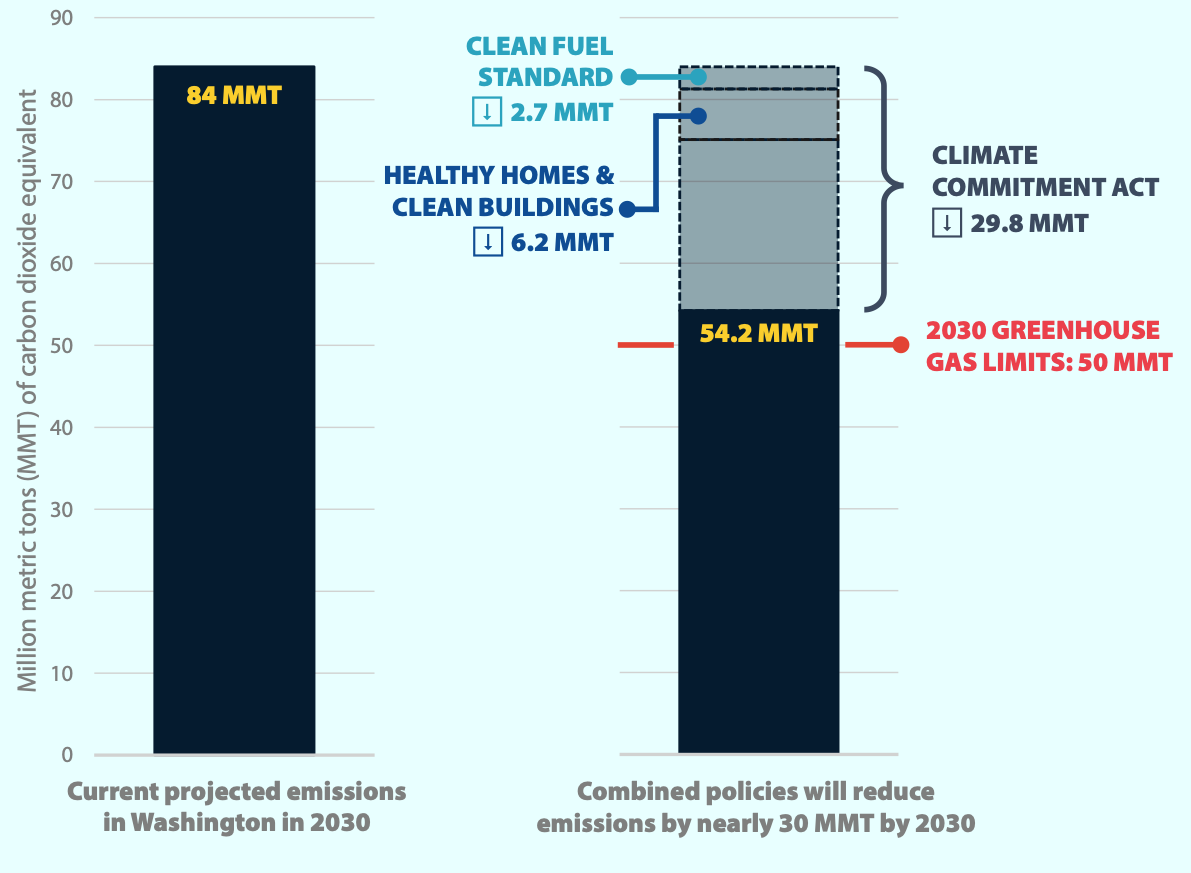Recently, Governor Inslee claimed he had not heard any alternative policy recommendations to his expensive and ineffective climate agenda. So, I sent a certified letter to his office outlining the alternative approach we've been suggesting for years. We will share the receipts when we receive them, to make sure the governor acknowledges that there is an alternative.
Here is the letter we sent.
Dear Governor Inslee,
In your recent interview with Austin Jenkins on TVW, he asked you about the high cost and poor results of the low-carbon fuel standard (LCFS) that you propose as part of your new climate strategy.[1] In response you claimed that the LCFS is the “single most economically effective thing to actually save us from the ravages of climate change,” and you cited the results in California. You went on to say, “It's for those who criticize our proposals and … don't actually propose policies that get this job done is grossly irresponsible.”
As you must know, both of those statements are false. The climate expenditures and policies you propose are some of the least effective and most expensive policy options a state would follow, as California’s experience demonstrates. Additionally, there are many more effective options – policies that we at Washington Policy Center have responsibly offered for several years now. If, however, your comments were sincere rather than simply political rhetoric, I have outlined an effective alternative to your policies, one that is both less expensive than your proposal and is certified to reduce CO2 emissions, which yours are not.
We are happy to answer any questions you have about our practical and responsible strategy.
Learning from Washington’s failure
When answering Mr. Jenkins’ question, you noted that you wanted to “start this discussion by talking about what's at stake,” saying “the preservation of our state literally as we know it” was on the line. With the stakes so high, it is important to reflect on why Washington officials have done so poorly at meeting our CO2-reduction targets.
For example, Washington’s CO2 emissions have increased almost every year since 2012, reaching the highest level in a decade in 2018. Washington state is unlikely to meet the 2020 target, even with the reduction in emissions created by the COVID lockdowns.
Your administration has also repeatedly missed its own internal goals. Although the promised goals have since been removed from the page, of the 10 goals set in Results Washington in 2013,[2] the state was missing virtually all of the targets.
The lesson from such failures should be that state need to broaden the scope of potential solutions, focusing on results rather than political headlines. Your current 2021 legislative proposal for climate spending and regulation does not learn these lessons and throws good money after bad.
Instead, we recommend you return to a concept you introduced in your first climate legislation, ESSB 5802 in 2013 – a policy proposal we supported and testified in favor of – which said climate expenditures “must be prioritized to ensure the greatest amount of environmental benefit for each dollar spent and based on measures of environmental effectiveness.”[3] Your proposed 2021 budget ignores this important principle.
For example, your budget includes $50 million for energy retrofits for public buildings, $55 million for weatherization, and $100 million for the Clean Energy Fund.[4] There is no estimate of how much CO2 these expenditures will generate, in large part because these expenditures are speculative or have very low return. For example, Michael Greenstone, who served as Chief Economist for President Obama’s Council of Economic Advisors, found “the costs still substantially outweigh the benefits” of weatherization programs.[5] Additionally, expenditures that focus on reducing the carbon-intensity of electricity, such as the installation of solar panels, yield tiny reductions in CO2 because Washington already ranks fourth-lowest in the carbon-intensity of its electricity.[6]
The net CO2 reduction from $200 million in expenditures will be negligible. If, however, you believe these expenditures would yield meaningful results, they should be quantified.
The proposed low-carbon fuel standard also violates the principle you previously supported of prioritizing policies that have the “greatest amount of environmental benefit for each dollar spent.” Far from being the “single most economically effective” climate policy, the LCFS is one of the least effective.
You cite California as evidence of the LCFS’s effectiveness. Currently, California’s LCFS costs consumers $196 to reduce one metric ton (MT) of CO2.[7] Compare that to $38 per MT on the European carbon market, the current California carbon price of about $20, and the current price in the Northeast’s Regional Greenhouse Gas Initiative of $7.41. Groups like the Bonneville Environmental Foundation charge $10 per metric ton of CO2. Seattle City Light pays less than that. At best the LCFS wastes about 80 percent of the cost to reduce CO2. Compared to the price in the Northeast, California’s LCFS policy wastes 96 percent. The more serious the risk from climate change, the more irresponsible it is to waste that amount of money and the more shocking the violation of the principle of prioritization that you once espoused.
That high price is compounded by the dead weight loss incurred to simply implement the program. Your budget summary indicates a cost of about $15 million to implement the LCFS and a few other climate-related policies. Assuming one-third of that is for the LCFS, the state could invest in projects that reduce CO2 emissions by half-a-million metric tons, the equivalent of emissions from about 100,000 cars for a year. Instead, it would go to administration, reducing no emissions at all.
An effective alternative to Washington’s failed policies
Fortunately, there is an effective alternative that would yield certified CO2 reductions immediately and would cost much less than the policies you propose.
Washington state leaders should take the funding they propose to spend on ineffective climate projects and agency administration and spend it instead on CO2-reducing projects currently available on the market and certified by groups like Green-e[8], the Verified Carbon Standard[9], and the Climate Action Reserve.[10] These professional standards have been recognized as effective and are approved, for example, by the state of California as part of its own carbon market.
 These investment would also yield immediate reductions. By way of comparison, your proposed LCFS policy would reduce 2.7 million metric tons a decade from now.[11] For $27 million, Washington state could produce that level of reduction immediately, and for a fraction of the $200+ million proposed in your budget. You could spend one-quarter of what you have proposed and get double the total CO2 emissions reduction in 2021 for the benefit of the planet.
These investment would also yield immediate reductions. By way of comparison, your proposed LCFS policy would reduce 2.7 million metric tons a decade from now.[11] For $27 million, Washington state could produce that level of reduction immediately, and for a fraction of the $200+ million proposed in your budget. You could spend one-quarter of what you have proposed and get double the total CO2 emissions reduction in 2021 for the benefit of the planet.
Additionally, the additional funding could be used to address a range of issues you cite. It could be used to supplement funding to restore forests to a healthy, fire-resilient state that are a major cause of the smoke you say Washington residents are choking on. You can use it to fund salmon recovery or help meet the requirements of the court order to repair culverts. Those resources could be used to aid the many small businesses that are struggling or have gone bankrupt. The money would be welcome to low-income families whose children have been especially hard hit by the lockdown and the problems of virtual learning. Any of these options would be superior to spending taxpayer dollars for zero climate benefit.
A commitment to climate effectiveness would also create a strong incentive to innovate, finding new technologies that yield CO2 reductions at low cost. Such innovations are key to meeting the more aggressive targets state leaders set themselves for 2040 and 2050. The current system of politically driven technology mandates like the LCFS, by way of contrast, narrow the scope of innovation, and require innovators to hire lobbyists to deal with the government process that is necessary to qualify for subsidies and regulatory mandates.
Technology solutions are also the most consistent with economic growth – finding ways to do more with less – and preserving personal liberty that is at the heart of a free society.
Put simply, this approach is the moral alternative to the history of failed policies that waste time and money as the state’s CO2 emissions continue to increase.
Standard objections
As we noted, contrary to your claim that there are no alternatives, we have proposed these practical and responsible ideas before and there are some standard objections raised in opposition to this approach.
First, some have argued that we cannot “offset” our way to CO2 reductions. The claim is that we must act ourselves rather than investing in projects that reduce CO2 elsewhere. This is a strange argument because paying others for projects that cut CO2 emissions is, quite literally, what your proposed policy does. It pays others to install solar panels, or use biofuel, or install electric vehicle charging stations. The only difference between our proposal and yours is that we demand the emissions reductions be certified and achieved for the lowest cost.
Second, some will justify the low-carbon fuel standard or other expenditures by citing goals other than climate benefits, such as job creation or equity. Such excuses demonstrate that reducing the global risk from climate change isn’t really the primary goal. As noted above, the LCFS wastes 95 percent of the cost to subsidize other purported goals. Some of these goals are purely political, not related to climate, while others can be delivered at lower cost, and some are simply fictional. For example, the Puget Sound Clean Air Agency’s analysis found the LCFS delivers negligible air quality benefits and would not create a new biofuel industry in the region.[12] Similarly, as we noted above, weatherization projects have a poor return on investment for recipients and the climate.
Even if some of these limited benefits were provided under your proposal, sacrificing effective CO2 reduction is counterproductive.
After what must have been a frustrating several years, we encourage you to return to the principles you outlined when you were first elected. By prioritizing climate expenditures based on what yields the most CO2 reduction per dollar and the most benefit for the environment, you can help the state meet its climate goals rapidly and effectively. You will also find us, once again, happily testifying in support of your responsible climate policy.
The alternative is to continue to do the same things that have lead to our current failure. The choice is there to be made. If climate change is as serious as you say it is, the choice should be clear.
Sincerely,
Todd Myers
Environmental Director
Washington Policy Center
[1] TVW, “Inside Olympia,” December 17, 2020, https://www.tvw.org/watch/?clientID=9375922947&eventID=2020121102
[2] Results Washington, “Goal 3: Sustainable energy & a clean environment – Goal map,” https://results.wa.gov/measuring-progress/archived-outcome-measures/goal-3-sustainable-energy-clean-environment-goal-map (Accessed December 21, 2020)
[3] Washington State Legislature, “Engrossed Second Substitute Senate Bill 5802,” https://apps.leg.wa.gov/documents/billdocs/2013-14/Pdf/Bills/Senate%20Passed%20Legislature/5802-S2.PL.pdf
[4] Office of Governor Jay Inslee, “Proposed 2021-23 Budget & Policy Highlights,” December 2020, p. 54, https://ofm.wa.gov/sites/default/files/public/budget/statebudget/highlights/budget21/Proposed_2021-23_Budget_and_Policy_Highlights.pdf
[5] Meredith Fowlie, Michael Greenstone, Catherine Wolfram, Do Energy Efficiency Investments Deliver? Evidence from the Weatherization Assistance Program, The Quarterly Journal of Economics, Volume 133, Issue 3, August 2018, Pages 1597–1644, https://doi.org/10.1093/qje/qjy005
[6] U.S. Energy Information Administration, “Washington Electricity Profile 2019,” November 2, 2020, https://www.eia.gov/electricity/state/washington/
[7] California Air Resources Board, “Dashboard | California Air Resources Board,” https://ww3.arb.ca.gov/fuels/lcfs/dashboard/dashboard.htm (Accessed December 21, 2020)
[8] Green-e, https://www.green-e.org/
[9] Verra, “Verified Carbon Standard,” https://verra.org/project/vcs-program/
[10] Climate Action Reserve, https://www.climateactionreserve.org/
[11] Queary, Paul, “The politics of Inslee’s climate package,” December 16, 2020, https://washingtonobserver.substack.com/p/the-politics-of-inslees-climate-package
[12] ICF, “Puget Sound Regional Transportation Fuels Analysis – Final Report,” September 2019, https://pscleanair.gov/DocumentCenter/View/3809/Clean-Fuel-Standard-Technical-Analysis---Final-Report?bidId=




